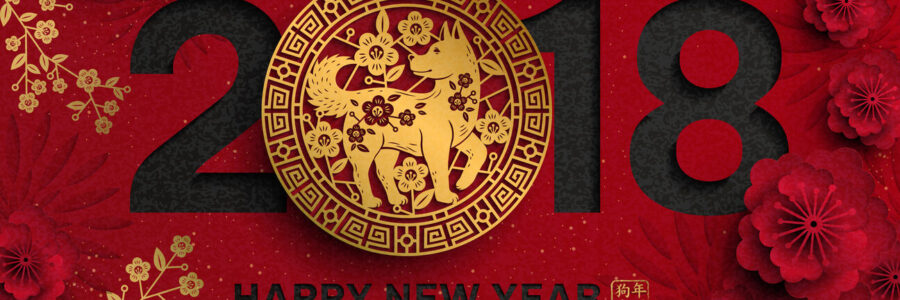Chinese New Year typically begins when the new moon rises between the end of January and the end of February. It lasts 15 days until the full moon arrives and ends with the Festival of Lanterns. The majority of Chinese New Year traditions began as an effort to appease the gods and spirits in order to earn another year of health and prosperity. Though modern Chinese are less likely to uphold the superstitious aspects, the traditions are mostly enjoyable, shared with extended family and give a great excuse to celebrate. Here is a guide of traditions that are typically followed.
Clean House
A week before New Year’s begins, everyone cleans their house. The entire house is scrubbed cleaned to clean the slate for a new year, get rid of “huiqi,” or inauspicious breaths (spirits), which may have collected during the past year and appease the gods who would be coming down from heaven to make inspections.
Lucky Red Decorations
Every street, building, and house is decorated with red because it is the most auspicious color. Red is the symbol of energy, happiness and good luck. Therefore, red lanterns are hung in streets; red couplets are pasted on doors; and banks and official buildings are decorated with red New Year pictures depicting images of prosperity.
Most public decoration is set-up a month before, but home decorations are traditionally placed on Chinese New Year’s Eve. Since 2018 is the Year of the Dog there will be red dog dolls for children, red dog themed decorations and paintings, everywhere.
Reunion Dinner
The New Year’s Eve dinner is called ‘reunion dinner’, and is the most important meal of the year. Several generations of one family will sit together around round tables and enjoy an 8-course meal (because 8 is the luckiest number!). Dishes with auspicious meanings must be included in the dinner such as fish, dumplings, and spring rolls. In the first five days of the New Year, people eat long noodles (that you cannot break to eat!) because they symbolize long life. On the 15th and final day of the New Year, round dumplings shaped like the full moon are shared as a sign of the family unit and of perfection.
Fireworks at Midnight
The first minute of the New Year, fireworks are launched. It is believed that the louder and brighter, the better since these will ward off all evil spirits. As the legend states, a monster called Nian would come out to eat villagers and destroy their houses on each New Year’s Eve. The villagers discovered that burning dry bamboo to produce an explosive sound scared away the monster. Since then, it has become a tradition at Chinese New Year. Nowadays, spectacular firework presentations are done throughout China. They are some of the most magnificent in the world.
Red Envelopes
Giving red envelopes is a way to share your own blessings, and bestow good wishes and luck (as well as money) to everyone you care about. Therefore, it is impolite to open a red envelope in front of the person who gives it to you. Generally, on Chinese New Year’s Eve or New Year’s Day, parents will prepare a red envelope and put it in their children’s pockets. The amount you put in the envelope can also determine luck…or not! The number ‘4’ in Chinese sounds like ‘death’, so this is considered bad luck. Even numbers, except four, are better than odd. It is best if the amount starts or ends in eight since eight is the luckiest number. Nowadays, modern people can send cyber red envelopes via WeChat!
The Lantern Festival
Chinese New Year holiday officially ends with the Lantern Festival which celebrates family reunions and society. Many activities of the day’s activities include moon gazing, lighting lanterns, riddles, lion dances and eating rice balls. Often the type of lantern you choose to light will signify your wish for the New Year. For example, Kongming lantern represents hope, success and happiness. In the past, people used these lanterns to signify they were safe after an attack. Now, they are used for wishes. Another, called the sky lantern which means in Chinese “adding children”. Lanterns would be gifted to newlyweds or couples without children to pass on the blessings. Pregnant women would receive a pair of small lanterns to wish health and safety on both mother and child.
Before Chinese New Year finally ends, the family reunites once again. The final celebration is all about families so typically they will take a break from the celebrations and reconnect under the moon, enjoy firework shows while eating a bowl of yuan xiao.
I hope you enjoyed this quick guide on how to bring health and prosperity into 2018. Happy Year of the Dog!
Want to Learn More?
Click HERE to get the Amethyst Holistic Skin Solutions Newsletter. You’ll receive interesting information about skin health via articles, before/after pictures, case studies of Amethyst patients, videos, interviews and more. Feel free to share this article with someone who you think may benefit.
About the Author
Olivia Hsu Friedman, LAc, Dipl.OM, DACM, Cert. TCMDerm, is the owner of Amethyst Holistic Skin Solutions and treats Acne, Eczema, Psoriasis, and TSW. Olivia treats patients via video conferencing using only herbal medicine. Olivia is Chair of the Board of Directors of the American Society of Acupuncturists, serves on the Advisory Board of LearnSkin, and is a faculty member of the Chicago Integrative Eczema Group sponsored by the National Eczema Association.



